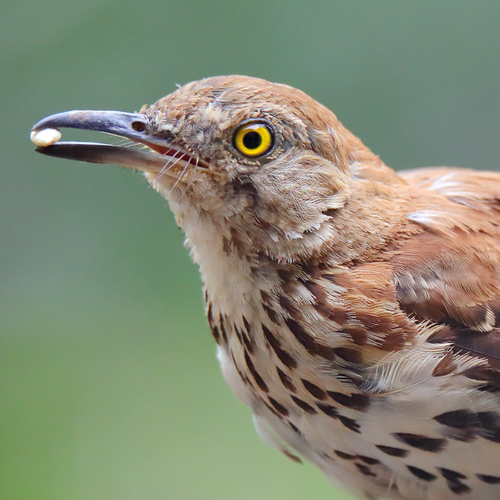
Brown Thrasher
The Brown Thrasher (Toxostoma rufum) is a large, striking songbird of eastern North America, known for its rich, rufous plumage and impressive vocal repertoire. It plays a significant role in its ecosystem as both a seed disperser and a consumer of insects, helping to maintain a balance in the populations of various plants and invertebrates. While not currently considered globally threatened, its populations are sensitive to habitat loss and fragmentation. The Brown Thrasher is the state bird of Georgia, reflecting its cultural significance in the southeastern United States.
23.5-30.5 cm
Length
29-33 cm
Wingspan
Least Concern
Conservation Status
Distribution
The Brown Thrasher is primarily found in the eastern and central United States and southeastern Canada. Its breeding range extends from southern Alberta, Saskatchewan, and Manitoba, east to Quebec and Maine, and south to Florida and the Gulf Coast. It migrates south for the winter, with some birds reaching as far as eastern Mexico.
Lifespan
Up to 12 years in the wild, but typically shorter.
Brown Thrasher's Habitat
Habitat Types
Dense thickets, Shrublands, Forest edges, Hedgerows, Suburban gardens with ample cover
Climate Zones
Temperate, Subtropical
Adaptations
Its strong legs and slightly decurved bill are well-suited for foraging on the ground and digging through leaf litter. Dense habitats provide crucial protection from predators.
Variations
Two subspecies are generally recognized: *Toxostoma rufum rufum* (eastern) and *Toxostoma rufum longicauda* (western), with the western subspecies having a slightly longer tail and paler plumage.
Appearance
Breeding Plumage
Plumage is similar year-round.
Seasonal Feather Changes
No significant seasonal variation.
Sex Based Plumage Differences
Males and females have similar plumage.
Notable Features
Bright rufous-brown upperparts, Heavily streaked, whitish underparts, Long, rufous tail, Yellow eyes, Slightly downcurved bill
Diet and Feeding
Primary Foods
Insects, Spiders, Berries, Fruits, Nuts, Seeds
Foraging Behavior
The Brown Thrasher primarily forages on the ground, using its bill to vigorously sweep aside leaf litter and soil in search of prey. It also gleans insects from vegetation and occasionally hawks insects in the air.
Specializations
Its strong bill and neck muscles are adapted for digging and turning over debris. It can also crack open hard-shelled nuts.
Seasonal Diet Variations
The diet shifts seasonally. Insects and other invertebrates are predominant during the breeding season, while fruits, berries, and seeds become more important in the fall and winter.
Behavior
Social Structure
Generally solitary or found in pairs during the breeding season. May form loose flocks during migration and winter.
Communication
Extensive vocal repertoire, with over 1,100 different song types recorded, Mimics other bird species, though less frequently than Northern Mockingbirds, Uses calls for alarm, contact, and territorial defense
Migration
Partial migrant. Birds in the northern part of the range migrate south for the winter, while those in the southern part are often year-round residents.
Territorial or Group Behaviors
Highly territorial during the breeding season, aggressively defending their nesting area from other birds. Males sing from exposed perches to delineate territories.
Conservation
Threats
Habitat loss and fragmentation due to agriculture and urbanization, Pesticide use, which reduces insect prey, Collisions with windows and vehicles, Predation by domestic cats
Protection Programs
Habitat restoration and preservation efforts, Promotion of bird-friendly landscaping practices
Local National Laws
Protected under the Migratory Bird Treaty Act in the United States.
Population Trend
Generally stable, but some regional declines have been observed.
Population Estimates
Partners in Flight estimates a global breeding population of 8.8 million.
Interesting Facts
The Brown Thrasher has one of the largest song repertoires of any North American bird.
This allows for complex communication and individual recognition.
They are known for their aggressive defense of their nests.
They will attack potential predators, including humans, that approach too closely.
Brown Thrashers sometimes use a behavior called "anting."
They rub ants on their feathers, possibly to remove parasites or soothe irritated skin.
Faqs about Brown Thrasher
What is the difference between a Brown Thrasher and a Wood Thrush?
Brown Thrashers are larger, have longer tails, yellow eyes, and streaked breasts. Wood Thrushes have spotted breasts, brown eyes, and a more upright posture.
Do Brown Thrashers visit bird feeders?
They are less common at feeders than some other species, but they may be attracted to suet, mealworms, or scattered seeds on the ground.
How can I attract Brown Thrashers to my yard?
Provide dense, shrubby vegetation for cover and nesting, offer a variety of food sources, and avoid using pesticides.
What should I do if a baby bird falls out of the nest?
Consult a professional for expert advice. If the bird is uninjured and the nest is accessible, the best course of action is often to return it to the nest. If this isn't possible, contact a local wildlife rehabilitator.
Copyright @ Nature Style Limited. All Rights Reserved.
 English
English